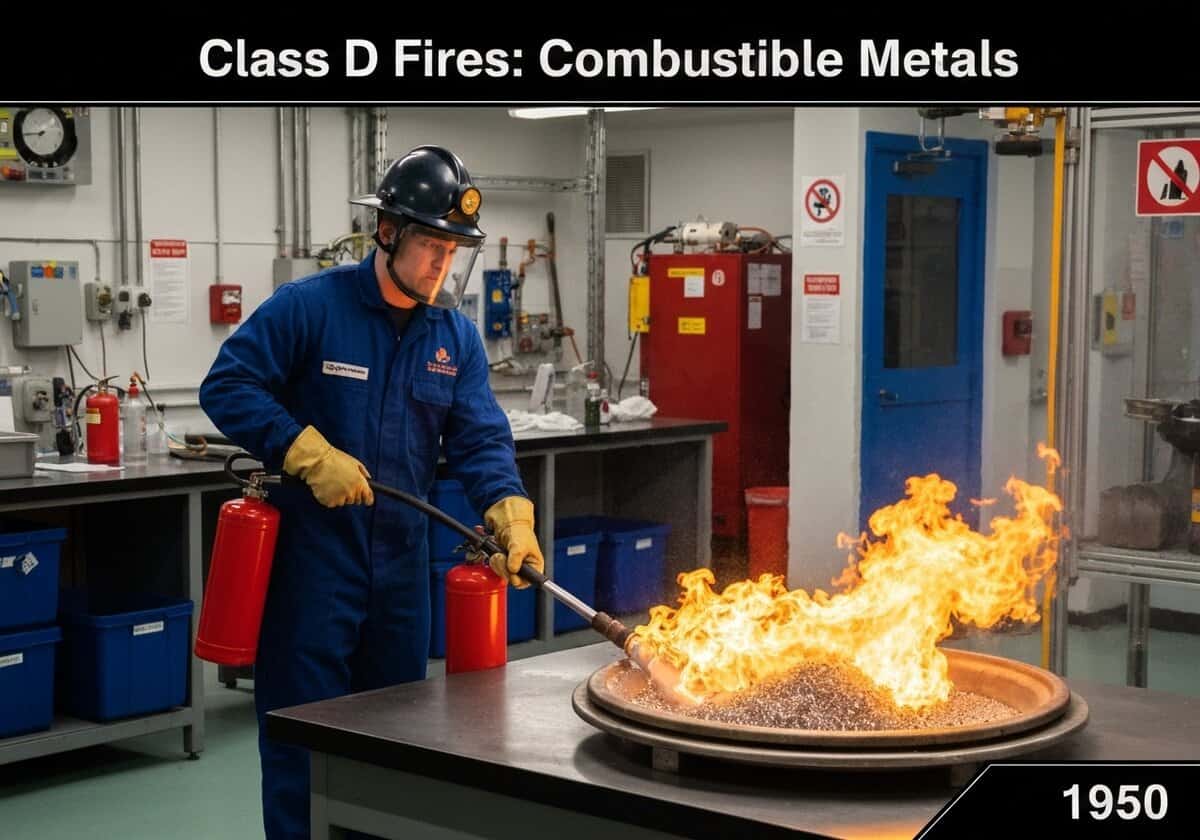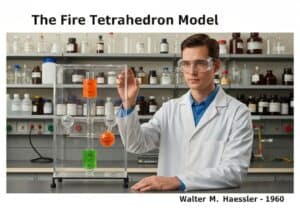Class D fires involve combustible metals, alloys, or metal compounds, such as magnesium, Titan, sodium, and Lithium. These fires are exceptionally hazardous as they burn at extremely high temperatures and can react explosively with common extinguishing agents like water or carbon dioxide. Water, for instance, in some cases, in contrary to popular believes, can dissociate into hydrogen and oxygen, fueling the fire. Specialized dry powder agents are required for extinguishment.
Class D Fires: Combustible Metals

The unique danger of Class D fires stems from the chemical reactivity of the burning metal. Unlike carbon-based fuels, many metals are powerful reducing agents and can strip oxygen from water (H₂O) or carbon dioxide (CO₂). For example, burning magnesium reacts with water in a highly exothermic reaction: [latex]Mg (s) + H_2O (g) \rightarrow MgO (s) + H_2 (g)[/latex]. The hydrogen gas produced is itself extremely flammable, leading to a violent explosion. This makes traditional firefighting methods not only ineffective but dangerously counterproductive.
Extinguishing Class D fires requires agents that will not react with the burning metal. These are typically dry powders, not to be confused with the dry chemical agents used for Class A, B, and C fires. Class D agents work by smothering the fire, forming a crust that excludes oxygen, and by absorbing heat. Common agents include sodium chloride (NaCl) based powders (like Met-L-X), graphite-based powders (G-1), and copper-based powders, with the specific choice depending on the type of metal burning. For instance, copper powder is particularly effective on lithium fires.
The rise of Technologien like lithium-ion batteries has brought Class D fire safety into sharper focus. While a battery fire is complex, it often involves the combustion of lithium, requiring Class D-rated extinguishing agents and strategies.
Typ
Unterbrechung
Verwendung
Vorläufersubstanzen
- the discovery and isolation of reactive alkali and alkaline earth metals
- the development of industrial processes using powdered or molten metals (e.g., in aviation and munitions)
- a scientific understanding of exothermic oxidation-reduction reactions
- analysis of industrial accidents involving catastrophic metal fires
Anwendungen
- fire safety protocols in aerospace and automotive industries using lightweight metals
- handling procedures for alkali metals in chemical research and Herstellung
- specialized fire suppression systems in metal foundries and 3d printing facilities using metal powders
- safety design for large-scale battery energy storage systems (e.g., lithium-ion)
- pyrotechnics manufacturing and storage safety
Patente:
Mögliche Innovationsideen
!Professionals (100% free) Mitgliedschaft erforderlich
Sie müssen ein Professionals (100% free) Mitglied sein, um auf diesen Inhalt zugreifen zu können.
VERFÜGBAR FÜR NEUE HERAUSFORDERUNGEN
Maschinenbauingenieur, Projekt-, Verfahrenstechnik- oder F&E-Manager
Kurzfristig für eine neue Herausforderung verfügbar.
Kontaktieren Sie mich auf LinkedIn
Integration von Kunststoff-Metall-Elektronik, Design-to-Cost, GMP, Ergonomie, Geräte und Verbrauchsmaterialien in mittleren bis hohen Stückzahlen, Lean Manufacturing, regulierte Branchen, CE und FDA, CAD, Solidworks, Lean Sigma Black Belt, medizinische ISO 13485
Wir suchen einen neuen Sponsor
Ihr Unternehmen oder Ihre Institution beschäftigt sich mit Technik, Wissenschaft oder Forschung?
> Senden Sie uns eine Nachricht <
Erhalten Sie alle neuen Artikel
Kostenlos, kein Spam, E-Mail wird nicht verteilt oder weiterverkauft
oder Sie können eine kostenlose Vollmitgliedschaft erwerben, um auf alle eingeschränkten Inhalte zuzugreifen >Hier<
Verwandte Erfindungen, Innovationen und technische Prinzipien














